Sawtooth Oak Tree
- December 29, 2023
- 0 comment
The Sawtooth Oak Tree (Quercus acutissima) is a deciduous tree renowned for its distinctive serrated leaves, giving rise to its name. Native to East Asia, particularly China and Japan, this ornamental tree has found its way into landscapes around the world due to its adaptability and aesthetic appeal. The leaves, resembling the teeth of a saw, exhibit a unique texture and vibrant green color during the growing season, adding visual interest to any environment.
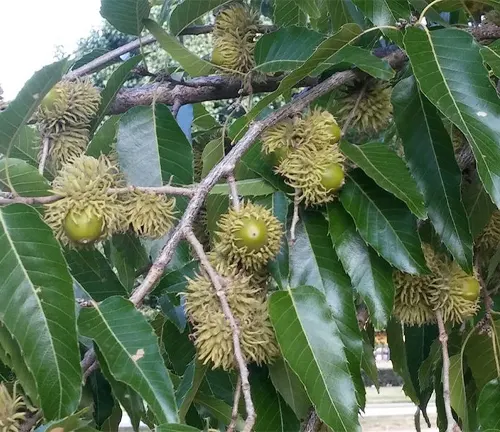
The Sawtooth Oak is valued not only for its picturesque foliage but also for its rapid growth, making it a popular choice for landscapers and gardeners seeking a relatively quick canopy. In addition to its visual charm, the tree produces acorns, serving as a crucial food source for various wildlife. Its adaptability to diverse soil types and climates makes it a resilient species, thriving in both urban and rural settings. Whether lining streets or enhancing backyard landscapes, the Sawtooth Oak Tree stands out as a testament to nature’s beauty and resilience.
| Characteristic | Description |
|---|---|
| Scientific Name | Quercus acutissima |
| Common Name | Sawtooth Oak Tree |
| Native to | East Asia (China, Japan) |
| Foliage | Deciduous |
| Leaf Shape | Serrated, resembling a saw |
| Leaf Color | Vibrant green during the growing season |
| Growth Rate | Rapid |
| Mature Height | Typically 40-60 feet (12-18 meters) |
| Adaptability | Thrives in diverse soil types and climates |
| Wildlife Value | Produces acorns, serving as a food source for wildlife |
| Landscape Use | Ornamental, suitable for urban and rural environments |
| Resilience | Highly adaptable and resilient |
| Environmental Impact | Enhances biodiversity by providing habitat and food sources |
Botanical Beauty of Sawtooth Oak Tree

The Sawtooth Oak Tree (Quercus acutissima) stands as a botanical marvel, captivating enthusiasts and nature lovers alike with its distinctive features. Admired for its serrated leaves, reminiscent of a saw’s teeth, this deciduous tree boasts a unique aesthetic that sets it apart. The intricate design and vibrant green color of its foliage make the Sawtooth Oak a true botanical beauty, gracing landscapes with a touch of natural elegance.
Woodland Elegance
In woodland settings, the Sawtooth Oak Tree adds an element of elegance that complements the surrounding environment. As the leaves sway gently in the breeze, the play of light and shadow on the serrated edges creates a mesmerizing spectacle. Whether as a solitary specimen or part of a larger woodland area, the tree’s graceful demeanor enhances the overall aesthetic, turning any space into a serene haven of tranquility.
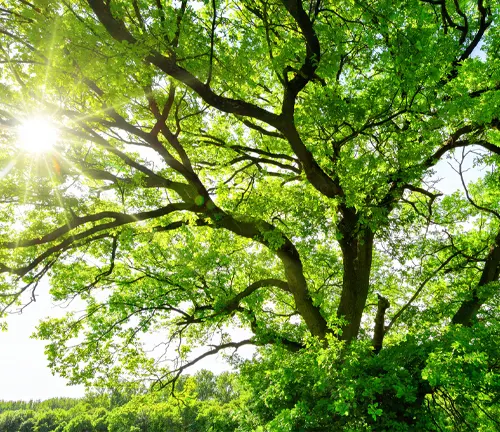
Ecological Importance
Beyond its visual appeal, the Sawtooth Oak Tree plays a vital role in the ecosystem. Native to East Asia, particularly China and Japan, this tree produces acorns that serve as a crucial food source for various wildlife. Its presence contributes to the biodiversity of a region, supporting a myriad of organisms in the intricate web of life. The ecological importance of the Sawtooth Oak extends beyond its immediate surroundings, making it a valuable asset in fostering a healthy and balanced ecosystem.

Cultivation and Conservation
The Sawtooth Oak tree has found favor in Japan for its use in cultivating shiitake mushrooms. Despite its widespread popularity among gardeners and landscapers due to its ability to thrive in various soils and climates, there’s a growing emphasis on conserving these trees. Preserving the natural populations of Sawtooth Oaks is crucial to safeguarding their ecological advantages and aesthetic appeal for generations to come.
Fragrance
In addition to its visual allure, the Sawtooth Oak Tree offers a subtle olfactory delight. The leaves emit a delicate fragrance, adding another sensory dimension to its appeal. A stroll beneath the canopy becomes a sensory experience, with the refreshing scent enhancing the overall ambiance. This fragrant quality further distinguishes the Sawtooth Oak, making it a favorite among those who seek a multisensory connection with nature.
Soil Stabilization
The robust root system of the Sawtooth Oak contributes to soil stabilization, making it an excellent choice for preventing erosion in various landscapes. The extensive network of roots helps anchor the soil, reducing the risk of runoff and soil degradation. This valuable attribute underscores the tree’s ecological contribution, showcasing its role not only above ground but also below the surface.

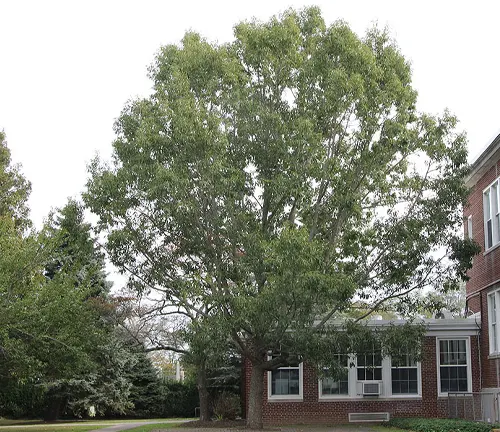
Common Uses
The versatility of the Sawtooth Oak extends to its common uses in landscaping, urban planning, and forestry. Whether lining streets for shade or enhancing the beauty of parks and gardens, this tree’s adaptability makes it a sought-after choice. Its resilience to urban environments highlights its ability to thrive amidst the challenges of city life, providing both aesthetic and environmental benefits.
Benefits
The Sawtooth Oak Tree offers a plethora of benefits, from its role in enhancing biodiversity to its contribution to soil stability. Beyond its ecological impact, the tree’s rapid growth and ornamental features make it a valuable asset in various settings. As a provider of shade, habitat, and aesthetic appeal, the Sawtooth Oak stands as a testament to the inherent connection between nature and human well-being, illustrating the profound benefits that trees bring to our lives and the planet as a whole.
Different Species
Japanese Evergreen Oak
(Quercus acuta)
This oak species, native to East Asia, including Japan, is sometimes confused with the Sawtooth Oak due to its similar name and geographic origin.
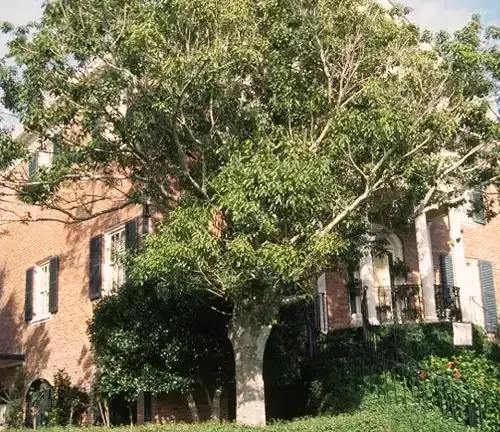
Sawtooth Black Oak
(Quercus acutissima x velutina)
Hybrid species resulting from the crossbreeding of the Sawtooth Oak and Black Oak. It may exhibit characteristics of both parent species.
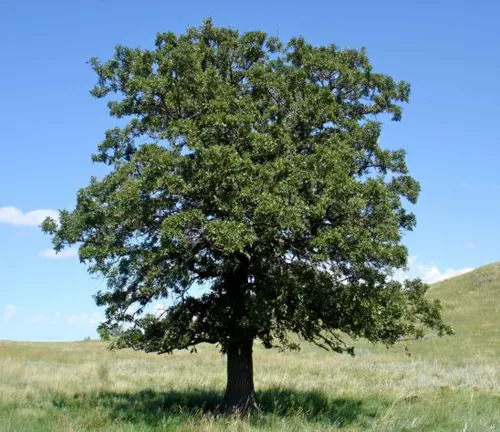
Frequently Asked Questions (FAQs)
1. What is a Sawtooth Oak Tree?
The Sawtooth Oak Tree (Quercus acutissima) is a deciduous tree known for its serrated leaves, resembling the teeth of a saw. It is native to East Asia, including China and Japan.
2. How tall does a Sawtooth Oak Tree typically grow?
Sawtooth Oaks generally reach a mature height of 40-60 feet (12-18 meters). Growth rates can be relatively fast.
3. What does the foliage of the Sawtooth Oak look like?
The leaves of the Sawtooth Oak are distinctive, with serrated edges, giving them a saw-like appearance. They are typically vibrant green during the growing season.
4. Are Sawtooth Oaks suitable for urban environments?
Yes, Sawtooth Oaks are known for their adaptability and can thrive in diverse soil types and urban settings, making them a popular choice for landscaping.
5. Do Sawtooth Oaks produce acorns?
Yes, Sawtooth Oaks produce acorns, and these serve as an important food source for various wildlife.
6. How do you cultivate and care for Sawtooth Oak Trees?
Sawtooth Oaks are generally hardy, but they thrive in well-drained soil and full sunlight. Regular watering and pruning may be necessary for optimal growth.
7. Are there different species of Sawtooth Oak Trees?
The term “Sawtooth Oak” typically refers to Quercus acutissima. There are related oak species, but the common name is most commonly associated with this specific tree.
8. What is the ecological importance of Sawtooth Oaks?
Sawtooth Oaks contribute to biodiversity by providing habitat and food for wildlife. Their root systems also aid in soil stabilization.
9. Can Sawtooth Oaks be used for landscaping purposes?
Yes, Sawtooth Oaks are commonly used in landscaping due to their aesthetic appeal, adaptability, and rapid growth.
10. How do you differentiate Sawtooth Oak from similar-looking oaks?
Pay attention to specific leaf characteristics and, if necessary, consult with a horticulturist or arborist for accurate identification.




Leave your comment